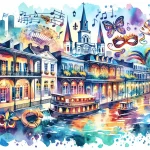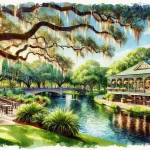Situated in the iconic French Quarter of New Orleans stands the Cabildo, a historic landmark that has witnessed the city’s captivating history unfold. This Spanish Colonial-style edifice, with its distinct architecture and storied past, is an essential attraction for anyone visiting the Crescent City.
In This Article
TL;DR
- The Cabildo played a pivotal role in the Louisiana Purchase transfer ceremony in 1803, marking its immense historical significance.
- Its architectural design, featuring Spanish Colonial elements, reflects the city’s diverse cultural influences.
- Today, the Cabildo serves as a museum, offering visitors a glimpse into New Orleans‘ rich history and heritage.
Historical Context of the Cabildo
Constructed between 1795 and 1799 under Spanish rule, the Cabildo’s origins date back to the late 18th century. Initially serving as the seat of the Spanish colonial government, the building played a crucial role in the Louisiana Purchase transfer ceremonies on December 20, 1803, when the territory was officially transferred from France to the United States.
Over time, the Cabildo has undergone numerous transformations, transitioning from a government building to a courthouse, and eventually finding its current purpose as a museum. In 1911, the Louisiana State Museum took over the Cabildo, preserving its rich history and making it accessible to the public.
Architectural Significance
The Cabildo as a Museum
The Cabildo is home to the Louisiana State Museum, a renowned institution dedicated to preserving and showcasing the rich cultural heritage of the state. The museum’s exhibits and collections offer visitors an in-depth exploration into the diverse histories and traditions that have shaped New Orleans over the centuries.
One of the most captivating exhibits is the “Louisiana Purchase” display, which chronicles the pivotal event that saw the transfer of the Louisiana Territory from France to the United States. Visitors can explore artifacts, documents, and interactive displays that bring this momentous occasion to life.
Other notable exhibits include the “Mardi Gras in New Orleans” collection, showcasing the vibrant history and traditions of the city’s iconic carnival celebrations, and the “Living with Hurricanes” exhibit, which explores the impact of these natural disasters on the region’s resilient communities.
Notable Events at the Cabildo
Throughout its storied history, the Cabildo has been the backdrop for numerous significant events that have shaped the course of New Orleans and the nation. From the Louisiana Purchase transfer ceremony to serving as the site of the Louisiana Supreme Court, the building’s walls have witnessed pivotal legal and political decisions.
One of the most notable events was the trial of the Poulson-Burke gang in 1919, which exposed the rampant corruption within the city’s government and law enforcement agencies. The trial, held within the Cabildo’s courtrooms, sparked a wave of reform and helped pave the way for a more transparent and accountable system of governance.
Additionally, the Cabildo has hosted numerous cultural events, celebrations, and gatherings, further cementing its role as a cornerstone of New Orleans’ vibrant community life.
Public Access and Visitor Information
The Cabildo welcomes visitors from around the world, offering a unique opportunity to immerse oneself in the rich tapestry of New Orleans’ history. Tickets can be purchased on-site or online, with discounts available for students, seniors, and military personnel.
Guided tours are available, providing visitors with an in-depth exploration of the building’s architecture, exhibits, and historical significance. These tours are led by knowledgeable docents who bring the Cabildo’s stories to life with their engaging narratives.
The best times to visit the Cabildo vary depending on the season and personal preferences. During the cooler months, visitors can enjoy a more comfortable outdoor experience while exploring the surrounding French Quarter. However, the summer months offer the opportunity to witness the city’s vibrant festival season, with events and celebrations taking place throughout the area.
Accessibility is a priority at the Cabildo, with ramps, elevators, and other accommodations available to ensure that all visitors can fully experience this historic gem.
Educational and Community Impact
The Cabildo plays a vital role in educating the public about New Orleans’ diverse cultural heritage. Through its educational programs and initiatives, the museum engages with local schools and communities, fostering a deeper appreciation for the city’s rich history and traditions.
One of the most notable programs is the “Cabildo Classroom,” which offers interactive workshops and hands-on activities for students of all ages. These programs not only impart knowledge but also encourage critical thinking and a deeper understanding of the region’s complex narratives.
Additionally, the Cabildo hosts community events and partnerships that bring together residents, historians, and cultural organizations. These collaborations foster a sense of pride and ownership in the city’s heritage, ensuring that the stories and traditions of New Orleans are passed down to future generations.
Preservation Efforts
Preserving a historic building like the Cabildo is no small feat, and the Louisiana State Museum, along with various government and private entities, has undertaken significant efforts to ensure its longevity.
Recent restoration projects have focused on addressing structural issues, preserving the building’s architectural integrity, and implementing modern conservation techniques. These efforts not only safeguard the Cabildo’s physical structure but also ensure that its historical significance remains intact for generations to come.
Ongoing preservation efforts also involve the digitization of archival materials, ensuring that the stories and artifacts housed within the Cabildo are accessible to researchers and the public alike.
The Cabildo in Popular Culture
The Cabildo’s iconic presence and rich history have made it a frequent subject of interest in popular culture. From appearances in literature and film to its influence on popular perceptions of New Orleans’ history, the building has captured the imagination of artists and storytellers alike.
Notable works that have featured the Cabildo include the novel “The Cabildo” by Lyle Saxon, which explores the building’s storied past, and the film “Interview with the Vampire,” which showcased the Cabildo’s striking architecture as a backdrop for the story’s gothic themes.
Beyond its physical presence, the Cabildo has also contributed to the cultural identity of New Orleans, serving as a symbol of the city’s resilience, diversity, and enduring spirit.
Expert Insights and Future Prospects
Historians and architects specializing in New Orleans’ built heritage have long recognized the Cabildo’s significance and the importance of preserving its legacy. The Cabildo is a living testament to the city’s multicultural roots,” says Dr. Emily Clark, a renowned historian at Tulane University. “Its preservation is not just about preserving a building but about safeguarding the stories and narratives that have shaped our collective identity.”
Looking to the future, the Louisiana State Museum has ambitious plans to further enhance the Cabildo’s offerings and ensure its continued relevance in the 21st century. From incorporating cutting-edge technology in exhibits to expanding educational outreach programs, the museum remains committed to keeping the Cabildo at the forefront of cultural preservation and public engagement.
As Dr. Clark eloquently states, “The Cabildo is more than just a building; it’s a living embodiment of our shared history, a testament to the resilience of the human spirit, and a reminder of the rich tapestry that makes New Orleans truly unique.”






